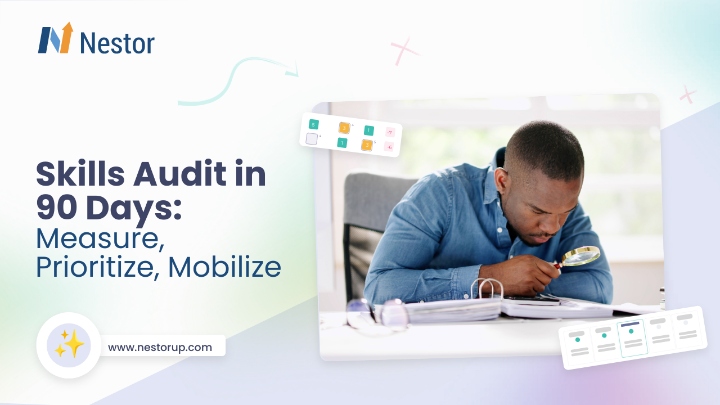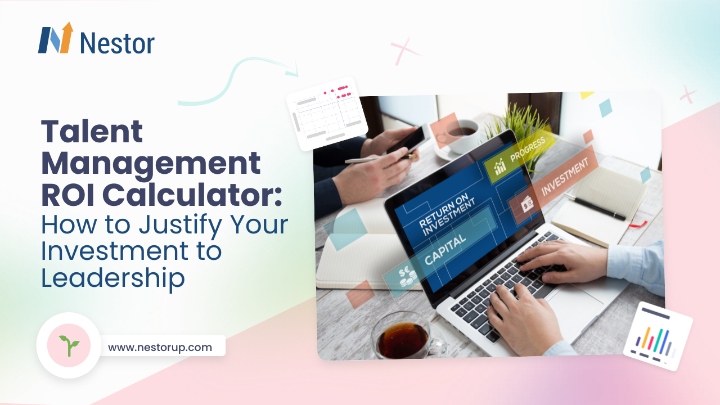
Contents
In a world where change is the only constant, the ability to swiftly adapt is no longer a luxury but a necessity for organizational success. Talent agility refers to the ability of employees and organizations to swiftly adapt, pivot, and thrive in the face of shifting market dynamics, technological advancements, and evolving customer expectations. It is about anticipating shifts in the environment and executing responsive strategies with precision and foresight. The imperative for talent agility is further emphasized by a survey from Deloitte.
94% of executives believe that agility and collaboration are critical to their organization's success.
— Deloitte
Picture this: You’re piloting a state-of-the-art drone through a complex obstacle course. The course is constantly shifting, with new barriers appearing and others vanishing in the blink of an eye. Your success depends not just on your piloting skills, but on the drone’s ability to reconfigure itself mid-flight – extending wings for stability one moment, retracting them the next for agility. This is talent agility in action.
But let’s focus more on real life examples. Take, for example, the transformation of companies like IBM. Once primarily a hardware manufacturer, IBM successfully pivoted to become a leader in cloud computing, AI, and blockchain technologies. This metamorphosis was made possible by a workforce capable of rapidly acquiring new skills and adapting to changing strategic priorities. Similarly, Microsoft’s resurgence under Satya Nadella’s leadership demonstrates the power of talent agility. By fostering a growth mindset and encouraging continuous learning, Microsoft successfully transitioned from a Windows-centric company to a cloud and services powerhouse.
Delving deeper into the significance of talent agility, we’ll examine its pivotal role in driving business success through enhanced innovation, optimized resource allocation, heightened employee engagement, and fortified organizational resilience. Additionally, we’ll explore actionable strategies to cultivate talent agility within your organization, equipping you to excel in an era characterized by perpetual transformation.
Welcome to the age of talent agility. Adapt or perish? No, adapt and conquer.
Why Talent Agility is Critical
In an era characterized by volatility, uncertainty, complexity, and ambiguity, businesses that fail to cultivate agility within their workforce risk obsolescence. With technology advancing at breakneck speed and consumer preferences shifting unpredictably, agile teams are crucial for navigating these challenges effectively. They not only adapt quickly to new technologies and market dynamics but also drive innovation and maintain competitive edge by anticipating and responding to changes swiftly. Here’s why talent agility is indispensable:
- Rapid Technological Advancements: With technology evolving at breakneck speed, companies must continuously update their skill sets to stay relevant. The half-life of skills is shrinking dramatically. What was cutting-edge just a few years ago may already be outdated. Talent agility ensures employees can adapt to new tools and processes quickly, enabling organizations to leverage emerging technologies for competitive advantage. It’s not just about learning new software; it’s about embracing a mindset of continuous technological evolution. Agile talent can quickly discern which new technologies are worth adopting and can spearhead their integration into existing workflows.
- Market Dynamics: Consumer preferences change rapidly, and businesses need agile talent to pivot strategies and innovate on the fly. The ability to sense market shifts early and respond swiftly can be the difference between leading the market and playing catch-up. Agile talent brings a customer-centric approach, constantly seeking to understand and anticipate consumer needs. This responsiveness allows companies to stay relevant, capture new market opportunities, and maintain customer loyalty in a world where brand allegiance is increasingly fickle.
- Competitive Advantage: Agile talent fosters a culture of continuous improvement and innovation, which is crucial for staying ahead of competitors. In a landscape where disruption can come from anywhere – established rivals, nimble startups, or even companies from entirely different sectors – organizations need employees who can think creatively, challenge the status quo, and drive innovation. Agile talent brings diverse perspectives across departments. This collective intelligence becomes a powerful engine for developing unique solutions and breakthrough products that set a company apart.
- Crisis Management: In times of crisis, such as economic downturns or global pandemics, agile talent enables organizations to respond swiftly and effectively. The COVID-19 pandemic has vividly demonstrated the value of workforce agility. Companies with agile talent were able to rapidly shift to remote work, repurpose production lines, or pivot their business models entirely. This resilience is not just about surviving crises, but about identifying opportunities within them. Agile talent can help organizations emerge from disruptions stronger, having developed new capabilities and explored new markets.
Benefits of Talent Agility
The benefits of fostering talent agility are transformative and essential. Beyond enhancing adaptability, talent agility enables organizations to embrace uncertainty as an opportunity rather than a threat. It empowers teams to pivot swiftly in response to market shifts, fostering innovation and ensuring competitiveness. Agile talent not only drives operational efficiency and optimized resource allocation but also nurtures a culture of continuous learning and cross-functional collaboration.
- Improved Employee Engagement and Retention
Today’s workforce, particularly younger generations, craves growth, purpose, and diverse experiences. Talent agility satisfies these desires by providing opportunities for employees to work on varied projects, learn new skills, and make meaningful impacts across the organization. This variety keeps work engaging and challenging, fostering a sense of continuous growth. As a result, companies with agile talent models often see higher levels of employee satisfaction, engagement, and retention.
- Cost Efficiency
Agile talent management can lead to significant cost savings. By developing a versatile workforce capable of performing multiple roles, organizations can reduce their reliance on external hires and contractors. This internal talent mobility minimizes recruitment costs and shortens the time needed to fill critical positions. Instead of being constrained by rigid job descriptions, agile organizations can dynamically assign talent to where it’s needed most. This fluidity ensures that high-priority projects are always staffed with the right mix of skills, regardless of traditional departmental boundaries. It also reduces the need for constant hiring and firing cycles, as existing talent can be reskilled and redeployed as business needs evolve.
- Attraction of Top Talent
Organizations known for their agile and dynamic work environments are more attractive to top talent. High-performing individuals seek opportunities where they can continuously learn, grow, and make an impact. By fostering talent agility, companies can position themselves as employers of choice, attracting the best and brightest candidates who are crucial for driving future success.
- Regulatory and Compliance Adaptability
In many industries, regulatory landscapes are constantly shifting. Talent agility ensures that organizations can swiftly adapt to new compliance requirements, whether they’re related to data privacy, environmental standards, or industry-specific regulations. Agile talent can quickly internalize new rules, adjust processes, and even identify opportunities within new regulatory frameworks.
- Adaptive Leadership
Adaptive Leadership stands as the cornerstone of agile organizations, where leaders excel in navigating and leveraging change to propel their teams and organizations forward. These leaders thrive amidst volatility and ambiguity, embodying resilience, openness to new ideas, and proactive problem-solving. They encourage teams to challenge the status quo, experiment with new approaches, and embrace failure as a stepping stone to growth and improvement.
Fostering Talent Agility
By embracing flexibility and resilience, organizations can unleash the full potential of their teams, ensuring they remain adaptive and innovative in the face of evolving challenges. This approach goes beyond mere skill development; it’s about creating a culture where individuals are encouraged to explore new roles, skills, and ideas, fostering a collective ability to thrive amidst uncertainty. To harness the power of talent agility, organizations need to implement strategic initiatives that cultivate a flexible and resilient workforce.
Key strategies to build and sustain talent agility include promoting internal mobility, where employees are encouraged to explore different roles within the organization, gaining diverse experiences that enrich their skillsets and perspectives. Additionally, implementing a talent marketplace facilitates the strategic deployment of skills across projects and departments, optimizing resource allocation and enhancing collaboration. A Skills-Based Talent Strategy further supports agility by aligning learning and development initiatives with evolving organizational needs, ensuring that employees continually acquire and refine skills essential for innovation and growth. Here are key strategies to build and sustain talent agility:
Skills-Based Talent Strategy:
Shift from traditional job-based roles to skills-based talent management. This involves identifying critical skills required for future success and investing in continuous learning and development programs. This strategy requires a fundamental rethinking of how we define work. Instead of rigid job descriptions, organizations create fluid skill clusters that can be reconfigured as needed. This approach allows for greater flexibility in deploying talent and helps identify skill gaps more precisely.
Implementing a skills-based strategy also means reimagining recruitment, performance management, and career progression. Hiring focuses on acquiring diverse skill sets rather than filling predefined roles. Performance evaluations center on skill development and application. Career paths become more individualized, based on evolving skills and interests rather than a predetermined hierarchy.
Internal Mobility:
Encourage internal mobility to leverage existing talent for new roles and projects. This not only fills skill gaps quickly but also enhances employee satisfaction and retention. Internal mobility goes beyond traditional promotions. It includes lateral moves, cross-functional projects, and temporary assignments. This fluidity allows employees to broaden their skills, gain diverse experiences, and find new ways to contribute to the organization. According to insightful data from LinkedIn, the pathway to long-term retention within organizations can significantly hinge on internal mobility.
Workers who have moved internally have a 64% chance of remaining with an organization after three years, according to LinkedIn data. Meanwhile, employees who haven’t moved internally only have a 45% chance of being around after three years.
— LinkedIn
This data highlights the strategic advantage of fostering a culture that encourages and facilitates internal mobility. To promote internal mobility, organizations should break down barriers between departments and cultivate a culture that appreciates diverse experiences. This could mean forming cross-functional teams, introducing job rotation programs, or setting up mentorship networks that span various parts of the company.
Investing in a Talent Marketplace:
Develop a robust talent marketplace where employees can explore and pursue new opportunities within the organization. Nestor facilitate this by matching employees with internal gigs, projects, and new roles based on their skills and career aspirations. This not only boosts agility but also aligns individual growth with organizational needs.
A talent marketplace democratizes opportunity within an organization. It gives employees visibility into a wide range of projects and roles, allowing them to take charge of their own development. For the organization, it provides a real-time view of available skills and enables rapid assembly of teams for emerging needs.
Implementing a successful talent marketplace requires more than just technology. It needs a cultural shift towards transparency, trust, and employee empowerment. Managers need to be comfortable with their team members taking on projects outside their immediate purview, and employees need to feel safe exploring new opportunities without fear of repercussion.
Nestor Talent Marketplace is a cornerstone of our platform, designed to revolutionize how organizations manage and optimize their human capital. By democratizing access to internal opportunities, Nestor enables organizations to respond swiftly to changing business needs. Managers gain real-time insights into available skills across the workforce, facilitating the rapid formation of teams tailored to emerging challenges or projects. This agility not only enhances operational efficiency but also fosters a dynamic workplace culture where innovation thrives.
Using advanced algorithms, Nestor Talent Marketplace matches employees with relevant projects and roles based on their skills, competencies, and career goals. This ensures that every opportunity is a strategic fit for both the individual and the organization. Organizations gain a comprehensive view of available skills across their workforce in real-time. This visibility enables agile team formation and rapid response to emerging business needs, facilitating faster innovation and adaptation.
Data-Driven Talent Insights:
Leverage workforce analytics to gain real-time insights into your organization’s skills inventory, emerging skill gaps, and future talent needs. This data-driven approach allows for more proactive and strategic talent management. Advanced analytics and AI can help predict future skill needs based on market trends, technological advancements, and organizational strategy. This foresight enables organizations to start developing or acquiring critical skills before they become urgent needs.
Nestor leverages advanced workforce analytics to offer real-time visibility into your organization’s skills landscape. By harnessing AI and sophisticated analytics, Nestor empowers HR and people leaders to understand their workforce’s current capabilities, identify emerging skill gaps, and forecast future talent requirements with precision.
With Nestor, organizations can proactively plan for upskilling, reskilling, or external hiring to bridge emerging skill gaps before they impact operations. By analyzing market trends, technological advancements, and organizational strategy, Nestor predicts future skill needs, enabling strategic workforce planning that aligns with business goals.
Agile Performance Management:
Move away from annual performance reviews towards more frequent, forward-looking conversations about performance and development. Companies like Adobe and Deloitte have replaced traditional performance reviews with regular check-ins focused on ongoing feedback, agile goal-setting, and continuous development. This approach aligns better with the fast-paced nature of today’s business environment. It allows for quicker course corrections, more timely recognition of achievements, and better alignment of individual efforts with rapidly evolving organizational priorities.
Agile Workforce Planning:
Adopt more dynamic and scenario-based approaches to workforce planning. Instead of static, long-term plans, organizations need to develop the capability to quickly adjust their workforce composition in response to changing needs. This might involve maintaining a mix of full-time employees, part-time workers, and contingent talent that can be flexed as needed. It also requires closer alignment between HR, finance, and business strategy to ensure the workforce can quickly adapt to support new strategic initiatives.
How Nestor Supports Talent Agility
Nestor empowers organizations to enhance team agility through its advanced skills-based talent management platform. At its core, Nestor provides a comprehensive library of over 20,000 skills, augmented by AI-driven suggestions. This rich resource enables HR and business leaders to gain deep insights into their workforce’s capabilities and dynamically map their skills landscape.
By leveraging this visibility, organizations can strategically activate and deploy skills across teams and projects, ensuring that the right talent is allocated to tasks with precision. This agility in workforce planning is further facilitated by Nestor’s AI-powered smart-matching capabilities, which swiftly connect individuals with the requisite skills to project needs.
Central to Nestor’s support for team agility is its Talent and Opportunity Marketplace. This innovative feature connects employees with internal gigs, projects, and open roles based on their skills profile and career aspirations. This democratization of opportunity not only boosts employee motivation and engagement but also ensures that the organization can flexibly deploy talent to meet evolving business demands.
Schedule a free demo to learn how we can take your internal mobility and lateral moves to a whole new level.










